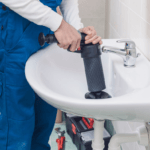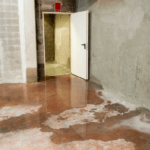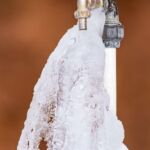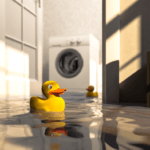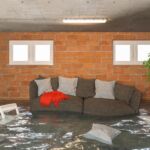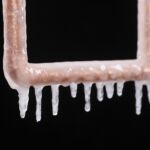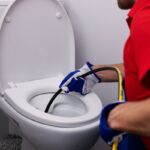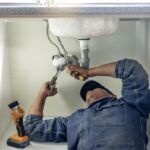
Nov 9, 2023 | Blogs
The possibility of frozen pipes becomes a serious concern for homeowners as winter’s frost sets in. Your home’s exposed pipes could freeze and potentially break when the temperature drops below freezing, resulting in water damage and expensive repairs. But with the correct precautions, you can safeguard your pipes and guarantee a worry-free and safe winter.
This article gives crucial advice for protecting your property, preventing pipes from freezing and avoiding the hassle of dealing with frozen and burst pipes.
Tips To Prevent Your Pipes From Freezing:
If you suffer from frozen pipes during winter, the following things will help prevent your pipes from freezing.
Keep Your House Warm
Keeping the interior warm is one of the most important stages in keeping pipes from freezing. Even while you are gone from home, keep the temperature on your thermostat consistent.
Maintaining the thermostat set at least 55 degrees Fahrenheit (12.8 degrees Celsius) is typically advised to avoid freezing your pipes. Even though you might be tempted to cut back on heating expenses, letting your house get too cold might result in frozen pipes and serious water damage.
Insulate Exposed Pipes
Unheated or inadequately insulated pipes are particularly susceptible to freezing. Use pipe insulation sleeves or heat tape to insulate any exposed pipes in your basement, crawl space, attic, or exterior walls.
By maintaining a greater temperature inside the pipes, this additional layer of defence lessens the likelihood that they may freeze. To keep cold air from leaking into the pipes, insulate any openings or cracks in the foundation and walls.
Seal Drafts and Openings
The likelihood of your pipes freezing increases if there are drafts around your windows, doors, and vents, which can let cold air into your house. To fill in any gaps and openings, use caulk and weatherstripping. To reduce cold air infiltration, consider adding door sweeps to outside doors.
Let Faucets Drip
Allow faucets along external walls to drip slightly on particularly cold nights. The risk of freezing can be decreased by allowing a small, continuous flow of water to prevent water from growing stagnant inside the pipes. Keeping faucets open can be an efficient preventive strategy because moving water is less likely to freeze.
Open Cabinet Doors
Open cabinet doors in rooms with colder temperatures, such as the kitchen and bathroom, to facilitate the flow of warm air from the rest of the house. This simple yet effective technique can make a significant difference in preventing pipes from freezing. Exposing the pipes under sinks and along exterior walls to the warmer indoor air creates an environment that reduces the risk of freezing.
As the warm air circulates the pipes, it works to maintain a more constant temperature. This, in turn, prevents the pipes from dropping to freezing temperatures and minimizes the possibility of ice formation.
Use Pipe Heating Cables
When dealing with remote or extremely cold locations, pipe heating cables are an efficient solution to prevent frozen pipes. These cables are designed to wrap around the pipes, providing a consistent and controlled source of low-level heat. By delivering this heat directly to the pipes, pipe heating cables create a buffer against freezing temperatures.
Pipe heating cables come with the advantage of being versatile and adjustable. They can be tailored to fit the length of your pipes and used on exposed and concealed pipes. Some advanced models even have built-in thermostats that activate the cables when the temperature drops to a critical level.
Drain Outdoor Faucets and Hoses
Outdoor hoses should always be disconnected and drained for two reasons. The first benefit is that it stops water from freezing inside the hoses, which might harm both the hoses and the linked pipes. The possibility of water backing up into faucets and freezing there is also decreased.
Simply disconnect the hoses from the outdoor faucets and let any remaining water drain out to implement this precautionary step. When the hoses are empty, store them somewhere protected. To further prevent water from entering the faucet and causing it to freeze, ensure the outdoor water supply is shut off.
Install Smart Home Technology
Think about investing in home temperature monitoring technology. If the temperature dips to a dangerous level, certain smart thermostats can send notifications to your smartphone, enabling you to take prompt action to avoid frozen pipes.
Consider Adding Insulation to Attics and Basements
In addition to helping prevent frozen pipes, a well-insulated attic and basement can contribute to overall energy efficiency. Pipes are less likely to freeze in these regions because of proper insulation, which creates a warmer atmosphere.
Prepare for Vacations
Take additional care to avoid frozen pipes if you intend to be away from home during the winter. Set your thermostat above freezing and enlist the help of a neighbour or dependable friend to routinely check on your house.
Understanding the Causes of Frozen Pipes
But before you implement the tips to prevent your pipes from freezing, it’s vital to know the cause of frozen pipes to tackle the situation effectively. When pipes are exposed to exceptionally cold temperatures, the water inside freezes, resulting in frozen pipes. This phenomenon is caused by several things, including:
- Temperature Drops: Exposed pipes are vulnerable to freezing when temperatures drop below zero, especially during protracted cold spells.
- Inadequate Insulation: Pipes in unheated places like basements, attics, crawl spaces, and external walls are more susceptible to freezing due to insufficient insulation.
- Lack of Heat: Pipes may not stay above freezing temperatures in locations with little heating, empty rooms, or deserted buildings.
- Exterior Faucets and Hoses: Because they are exposed to the cold air directly, outdoor faucets and hoses are more vulnerable to freezing. Frozen water in hoses can seep into the linked pipes.
The Risks of Frozen Pipes
Frozen pipes can lead to a cascade of problems, including:
- Burst Pipes: When water freezes inside a pipe, it expands and increases pressure. This pressure can cause pipes to crack or burst, leading to significant water damage.
- Water Damage: Burst pipes can release a significant amount of water into your home, causing damage to walls, floors, ceilings, and belongings.
- Structural Damage: The force of water from burst pipes can weaken the structural integrity of your home, leading to expensive repairs.
- Mold Growth: Water damage from burst pipes creates an environment conducive to mold growth, which can compromise indoor air quality and pose health risks.
- Disruption: Dealing with burst pipes requires immediate action, which can disrupt your daily life and routine.
Final Words
Pipe freezing must be avoided through proactive measures and thorough planning. Prepare your home for the impending winter’s chilly weather and probable freezing rain. You may have peace of mind knowing that your pipes are protected from freezing temperatures and that your home is protected from the dangers of frozen pipes by putting the proper preventive measures in place.
Experience Plumbing Excellence with Tap Tech
Are you in need of 5-star plumbing services catering to your residential and commercial needs? Look no further than Tap Tech – your trusted partner for plumbing excellence!
Tap Tech delivers unparalleled plumbing solutions for residential and commercial properties. With years of experience and a team of skilled professionals, we are equipped to handle a wide range of plumbing needs, from minor repairs to major installations.
Book Our Services Today!
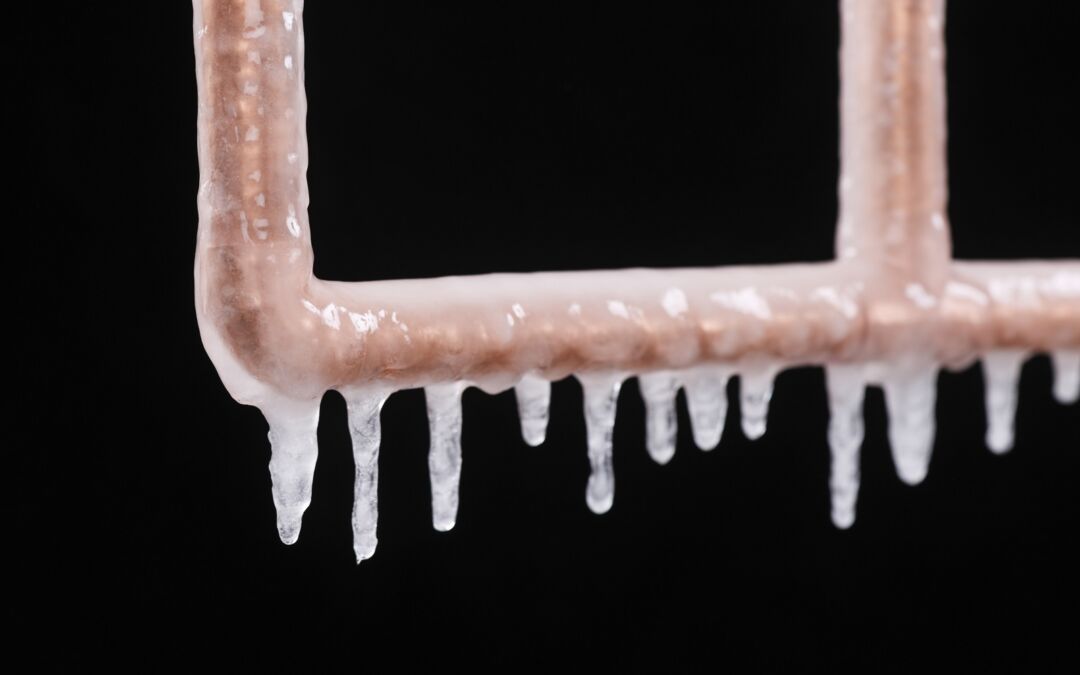
Nov 9, 2023 | Blogs
Many households have the dreaded prospect of frozen pipes as winter approaches. The water in pipes can freeze when it gets below freezing, which could result in damage and expensive repairs.
Knowing how to avoid frozen pipes and what to do if they do occur can help you avoid major hassles and costs. Dealing with frozen pipes can be frustrating. In this post, we’ll look at the reasons why pipes freeze, how to avoid them, and what to do if you have this common winter problem.
Understanding the Causes of Frozen Pipes
Understanding why pipes freeze in the first place is crucial before tackling prevention and solutions. The main culprits are:
- Exposed Pipes: Unheated locations like crawl spaces, attics, and basements have pipes that are more prone to freezing. The insulation that shields pipes from the cold outside is absent from these exposed pipes.
- Poor Insulation: Pipes might freeze if there is inadequate or worn-out insulation in the walls and around them.
- Sudden Temperature Drops: Sudden temperature decreases, particularly during very cold spells, can surprise homeowners and result in frozen pipes.
- Thermostat Settings: Frozen pipes can result from keeping your home’s thermostat too low, especially during prolonged cold spells.
Preventive Measures to Avoid Frozen Pipes
It is simpler and less expensive to prevent frozen pipes than to clean up the mess left by burst pipes and water damage. Here are some precautions you can take to protect your house:
- Insulate Exposed Pipes: Use foam pipe insulation or heat tape to insulate pipes in chilly places. By maintaining greater temperatures inside the pipes, this additional layer of defence will lessen the likelihood of freezing.
- Seal All Gaps and Cracks: Check your house for any gaps or cracks in the foundation, walls, and areas near windows and doors. To stop the infiltration of cold air, weatherstrip, caulk, or foam insulation should be used to seal these gaps.
- Keep Your Home Warm: Even when you’re away from home, maintain a constant indoor temperature. During cold spells, keeping your thermostat set above freezing will help prevent pipes from freezing.
- Open Cabinet Doors: Open cabinet doors in chilly rooms like the kitchen and bathroom so warm air may flow around pipes under sinks and close to exterior walls.
- Let Faucets Drip: During extremely cold nights, letting faucets drip a little bit might release pipe pressure and lessen the chance of freezing.
- Disconnect and Drain Outdoor Hoses: Drain garden hoses before winter sets in. Install insulated faucet covers and turn off the external water supply to prevent exterior faucets from freezing.
- Consider Smart Home Solutions: Spend money on gadgets that can track the temperature in your house and inform you if it lowers to a dangerous level. Some of these gadgets even let you change your thermostat remotely, which can help you prevent frozen pipes right away.
What to Do When Pipes Freeze
Even with all your precautions, frozen pipes can still happen. To reduce damage and restore water flow, take the following actions if you suspect that your pipes have frozen:
Keep the Faucets Open
If a faucet is turned on and only a trickle of water comes out, the pipe is probably frozen. As the ice in the pipe starts to thaw, keep the faucet open to release pressure.
Locate the Frozen Section
Use your home’s faucets to check for the frozen piece of the pipe. When several faucets barely produce a trickle of water or none at all, the frozen area is probably not far from the main water supply.
Apply Heat to Thaw Pipes
Use a hairdryer, heat lamp, electric heating pad, or cloths soaked in hot water to gently apply heat to the frozen pipe. Move toward the frozen part starting at the faucet end. Open flames and high-temperature heat sources should not be used since they can harm pipes or pose a risk to your safety.
Utilize Warm Air Circulation
Open doors in the affected area to let warm air from the rest of the home flow and help thaw the pipes. d. Use Warm Air Circulation.
Be Patient
It may take some time for frozen pipes to thaw; be patient and keep applying heat until the water begins to flow once more.
Check for Leaks
After the pipes have defrosted, look for any leaks or cracks. If you discover any damage, stop the water supply right away and call a qualified plumber for repairs.
Avoid Frozen Pipes in the Future
After the pipes have thawed and the water supply has been restored, take extra precautions by putting the earlier outlined preventive measures into practice to avoid future freezing.
Signs of Frozen Pipes
Understanding the symptoms of frozen pipes might help you respond quickly to limit further harm. Watch out for these warning signs:
- Reduced or No Water Flow: Frozen pipes may be the cause of a severely reduced or non-existent water flow when you turn on a faucet.
- Unusual Sounds: As water tries to pass through the ice blockage, frozen pipes may make odd noises like banging, rattling, or gurgling.
- Unpleasant Odours: A clogged pipe may cause drains or faucets to emit disagreeable odours.
- Frost on Pipes: In locations where pipes are visible, such as the basement or crawl space, frost on the pipe’s exterior is an obvious sign of freezing.
Using Safe Thawing Methods
Safety is crucial when attempting to thaw frozen pipes. Open flames and other high-temperature heat sources should never be used since they can damage pipes and even cause fires. Use secure procedures like hair dryers, heat lamps, or electric heating pads. Additionally, be cautious and use heating devices safely around electricity, never leaving them unattended.
Dealing with Persistent Frozen Pipes
Occasionally, despite your best efforts, you might run into pipes that are firmly frozen. It is necessary to bring in a licensed plumber if you are unable to defrost the pipes on your own or if there is visible damage. A qualified plumber has the knowledge and tools necessary to safely thaw and fix frozen pipes, avoiding further issues.
Long-Term Solutions for Frozen Pipe Prevention
While dealing with a frozen pipe problem is important, prevention is always the best course of action. Think about putting long-term fixes, like:
- Adding Additional Insulation: To protect pipes from freezing temperatures, increase insulation in crawl spaces, basements, and attics.
- Installing Pipe Heating Cables: As a preventative measure against freezing, think about employing pipe heating wires that encircle the pipes and offer a steady source of heat.
- Sealing Drafts: To stop cold air from getting to pipes, look for drafts around windows, doors, and vents and seal them.
- Keeping the Home Warm During Vacations: If you’re planning to leave the house during the winter, make sure your heating system is set to keep the house at a comfortable temperature to avoid frozen pipes.
Frozen pipes can be a homeowner’s worst winter nightmare, but with the right knowledge and preventive measures, you can protect your home from the risks of bursting pipes and water damage. Regularly inspect and insulate exposed pipes, maintain a consistent indoor temperature, and take advantage of smart home solutions to monitor your home’s temperature during cold spells. If you encounter frozen pipes, act promptly and apply gentle heat to thaw them, avoiding open flames or high-temperature heat sources.
Tap Tech: Your Trusted Ontario Plumbing Experts
Are you looking for reliable and expert plumbing services in Kingston, Gananoque, or Brockville Ontario? Tap Tech is here to cater to all your plumbing needs with unmatched professionalism and efficiency!
From drain and sewer cleaning to plumbing repairs and sump pump replacement to sewage pump installation, we’ve got you covered. Our skilled team specializes in a wide range of services, including clogged toilets, faucet installation, tub and shower valve installation, and leak repairs.
Book a Consultation with Us Today! ►
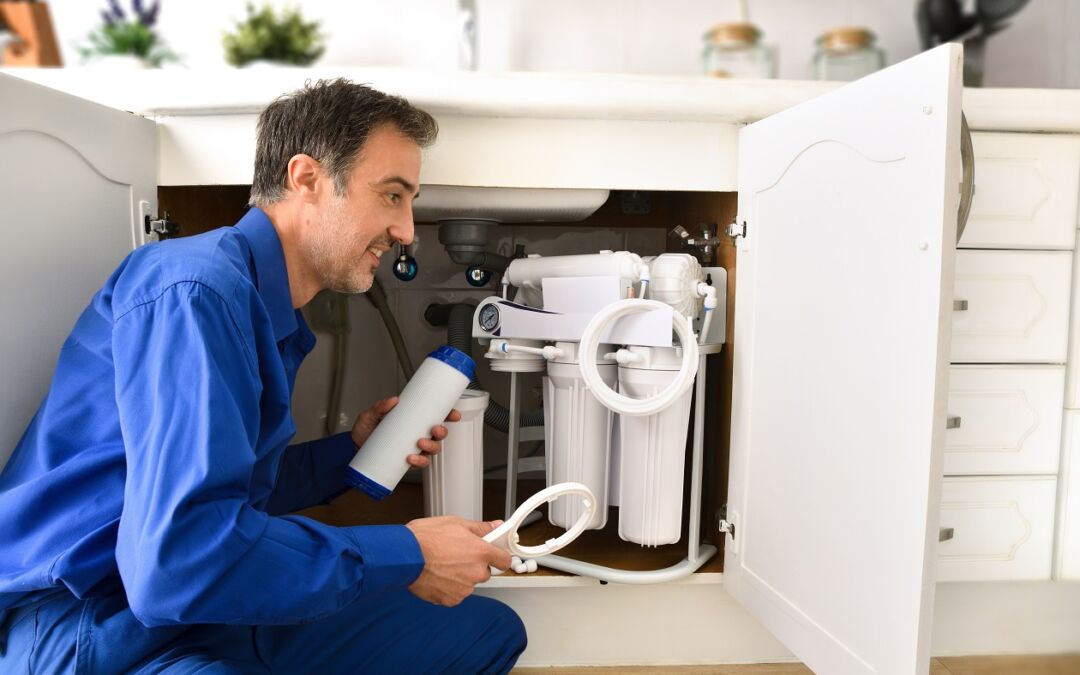
Jul 7, 2023 | Blogs, Plumbing services
Plumbing upgrades that improve functionality are usually the best way to increase your home’s value. This includes upgrading drains that run slow or clog easily.
Having your pipes replaced with modern materials is also another good plumbing upgrade to make your home more appealing to potential buyers. Old galvanized pipes are prone to corrosion and can cause numerous problems over time.
Dedicated Laundry Room
A dedicated laundry room is one of the top features homebuyers want in a new home. Most older homes include washers and dryers tucked away in a closet or adjacent to bedrooms, but upgrading to an open utility space is a great way to increase your home’s value.
Add a sink to your laundry room design for hand-washing delicates or soaking set-in stains. This space is also handy for washing mop water, rinsing dishes or filling pet water bowls. You can even use the sink to clean household items you don’t want to leave in the kitchen, like craft supplies or pet toys.
Install Eco-Friendly Fixtures
In a world where environmental protection is becoming more of a priority for homeowners, it’s important to know how to install eco-friendly products.
One of the most common goals during bathroom and kitchen remodels is to boost water and energy efficiency throughout the home. The simplest way to do this is by installing new household appliances that are certified by ENERGY STAR® Canada.
Another way to do this is by replacing old galvanized cast iron or clay piping with copper, PVC or PEX pipes. These are more durable and will not corrode over time. They are also a safer option than older piping that may contain lead. Replacing these older piping systems is an excellent way to lower your home’s risk of future sewage backups caused by heavy rainstorms or snow melt.
Upgrade Your Bathroom
A new bathroom can be a major selling point for your home, especially if you’re looking to sell. Adding one to your house may not only boost your resale value, but it can also make your home feel more spacious and comfortable for current or potential buyers.
Upgrade your toilets to energy-efficient models. A High Efficiency Toilet (HET) may reduce your water consumption by up to 4.8 litres per flush. According to BC’s regional government body, the CRD (Capital Regional District), older toilets typically use up to 13 to 25 litres per flush. In addition, you may receive a rebate for each low-flush toilet installed in your home.
Water Filtration
Another way to save water and improve the quality of your drinking water is to install a water filtration system. You can choose from a faucet-mounted or countertop water filtration system designed to remove unwanted elements from your water. This should improve your health over time, and ensure that your family is safe from toxins.
24/7 On-Demand Premium Plumbing Service
If your water heater breaks, or if you have a water leak in your home, do you know who to call? If you’re located in South Eastern Ontario, get in touch with Tap Tech’s expert, 5-star plumbers today.
We’ll get you an immediate quote over the phone, and dispatch our emergency plumbing technicians to your home within the same-day to ensure your plumbing emergency is quickly resolved.
Call your reputable, 5-start plumbers today at 343-305-1172 or book your appointment online.

Jul 5, 2023 | Blogs, Plumbing services
Plumbing problems happen at the most inconvenient times, and while some require a professional plumber, others can be solved by a homeowner with basic tools. Here are seven essential plumbing tools every homeowner should have on hand.
1. Plunger
There are different types of plungers available, and some may be better suited for specific applications. For example, a standard plunger works best for sinks and tub drains, while a flange plunger is ideal for toilets. If you can’t get a clog to budge, call a plumber and avoid chemical drain openers, which can damage your pipes.
2. Adjustable Wrench
A staple in every plumber’s tool bag, the adjustable wrench (also known as a crescent wrench) is used to tighten or loosen nuts and bolts. A prepared plumber works with an entire set of these wrenches to work on a variety of different pipes and fixtures.
This handy tool has the heft to lock onto pipe fittings without damaging them, and it comes in a number of different sizes to accommodate any situation. The handle is also a bit wider than many similar tools to feel comfortable in your hands and provide added torque when you need it.
3. Slip-Joint Pliers
A pair of pliers—specifically, slip joint pliers—are essential tools for plumbers. They allow professionals to loosen or tighten nuts and bolts too small for a wrench to grip, and to squeeze into narrow spaces where a standard screwdriver won’t fit.
4. Snake Camera
If you’re looking for a snake camera (also known as a borescope) to help with a tough sewer line clog or any other kind of visual inspection, make sure it has enough bright illumination. This feature is also important when working in wet or dusty conditions.
You should also check the IP rating on your chosen snake camera to ensure it can withstand wet environments. The higher the rating, the better it is for working in harsh conditions.
A snake camera is a great tool to have on hand. It can help identify the source of a problem and resolve it quickly and efficiently. It can also save time and money when compared to traditional methods, as it is less damaging and invasive with improved accuracy.
5. Pipe Cutter & Soldering Pliers
If your pipework is made of copper or plastic, you’ll need a tool to cut it. A ratcheting PVC tubing cutter is like super-strong scissors that can slice through these materials, and it’s one of the most essential plumbing tools for a homeowner.
Many plumbers seal copper piping by soldering it, and you’ll need a reliable tool for this task. A pair of adjustable soldering pliers can be used to loosen or tighten the solder on a copper pipe joint.
6. Drain Snake/Plumbing Auger
A drain snake, also called a plumbing auger, is a long metal cable that you feed down your sink or toilet drain to remove blockages. The head of the drain snake has many small hooks for snagging hair and soap scum buildup that accumulates in your drain line. You can find these tools at most home improvement stores. There are also power augers that have motors to generate more force, practical for larger lines with tough clogs.
To use the snake, first, loosen the screw at the end of the drum to extend the cable. Uncoil the cable slowly into the sink drain opening (or the p-trap, if you’ve removed it). Once you feel resistance, turn the crank to rotate the head and feed it further into the pipe. Keep rotating and feeding until you break up or clear the clog.
7. Sealant Tape
Plumbers often use thread sealing tape, sometimes called PTFE, plumber’s tape, or Teflon tape. This tool is essential to help patch and prevent possible leaks at pipe-threaded joint connections. These tapes are able to resist high and low temperatures, flex for better form-fitting coverage, and never dry out.
Plumber On-Demand Near You
If you’re in need of a plumber in South Eastern Ontario that provides same-day service with a 5-Star Experience, look no further than our expert team at Tap Tech.
For individuals and families who require a plumber NOW to quickly resolve a plumbing emergency, call 343-305-1172.
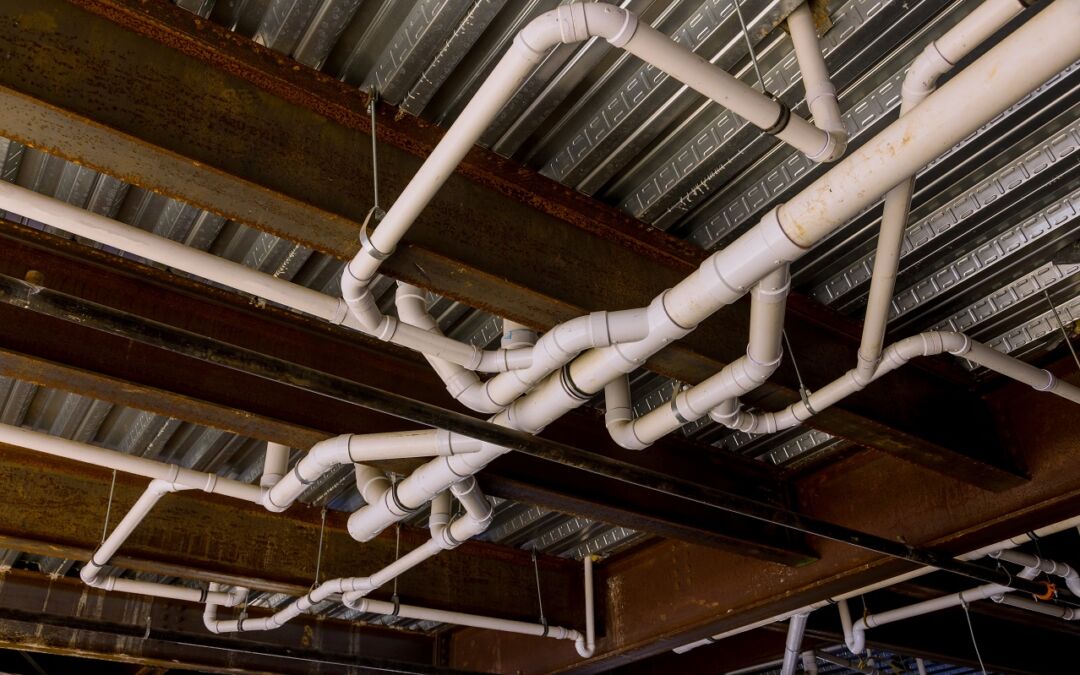
Jul 3, 2023 | Blogs, Plumbing services
The home plumbing system has two subsystems: water supply and drainage. The former brings pressurized water in, while the latter removes wastewater.
Understanding these systems can help a housing inspector recognize plumbing defects. Let’s begin with an overview of each component. Then we’ll move on to the basics of residential plumbing.
Plumbing Systems: The Basics
A residential plumbing system is a complex web of pipes that bring fresh water in, drain wastewater out, and connect all the fixtures in your home. A casual gaze at its interwoven mesh may make it seem overwhelming, but understanding the basics will help you navigate it like a pro.
City water enters your house through a huge pipe called the main. It is usually buried underground and made from copper, cast iron or galvanized steel. There are bridges over it all around your home that link your water service line to your plumbing pipes. These are called fixtures and include faucets, toilets, showers and dishwashers. As clean water enters a fixture, wastewater leaves through a downward-angled pipe called a drainpipe. This carries the waste to your sewer line.
Water Supply
The water supply system carries fresh, clean drinking water throughout the home, using pipes that can be made of copper, galvanized steel or PVC. These pipes can be buried underground, running under floors or between walls.
The water supply is typically connected to a water meter by the curb stop and to the city main by a service line. If a connection to another water source is desired, an application must be made to your municipal Water Department.
Water Filtration Systems
Water filtration systems remove contaminants from the water that enters your home, making it cleaner and safer to drink and use for other household purposes. These can include systems that can be attached to faucets or installed under the sink and plugged into any tap to provide filtered drinking water at the touch of a button. Only accredited professional plumbers should handle the installation, maintenance and repair of these systems.
All water pumps, tanks, wells, storage containers and other equipment containing potable water shall be effectively protected from contamination by means of covers, guards, copings and casings. They also need to be adequately insulated to prevent freezing and melting of the water supply piping in cold weather.
Water Heater
The water heater is another crucial component of your plumbing system. The tank itself is filled with a mixture of sediment, including scale, rust and bits of corroded anode that build up over time. This is why it’s important to have a drain valve on the bottom of your water heater to drain sediment from the tank periodically, e.g. every six months.
There is also a temperature control valve on the hot water service line to raise or lower the temperature of your water. This is typically set at 50 degrees Celsius and is generally the same as your hot water heater’s setting.
Drainage
Drain-Waste-Vent systems, or DWV, are responsible for the networks of drains that take waste away from fixtures and into the sewer system. They also work to keep the proper balance of pressure and air in the plumbing system, working to prevent drain clogs or wastewater back-ups.
In the past, most drainage was done through open drains that took up large amounts of land. However, newer drainage systems are often constructed with buried pipe drains that do not use any of the land and are more environmentally friendly. It is still important to maintain your sewer clean-out so that you can clear out the drain line from time to time.
Many homeowners don’t give a lot of thought to the drain and waste system until something goes wrong! A clogged shower or drain can be quite disruptive to daily life and requires fast action to remedy. Fortunately, South Eastern Ontario emergency plumbers are available on-call 24/7 with Tap Tech.
Call today at 343-305-1172.
Septic System
A septic system is an on-site sewage treatment system that handles household waste in areas where public sewer is not available. It consists of a house sewer drain, septic tank, and soil absorption field (or drain field). This system is designed to treat and dispose of wastewater without contamination, bad odours, or affecting the inhabitants’ health. A septic system is a great alternative to a sewer system for rural or remote areas where the cost and regulations of connecting to the main line are prohibitive.
A house sewer line collects all the discharge from toilets, showers, sinks, and other fixtures and connects to the septic tank. The septic tank holds the wastewater and allows it to separate into three layers. The floatable organic matter, such as grease and oils, floats to the top and forms a layer called scum. The heavier solids settle to the bottom of the tank and form a layer known as sludge. The liquid portion of the wastewater, called effluent, exits the septic tank into the drain field.
The septic tank also contains a vent that permits gasses to escape. The septic tank should be inspected and pumped regularly. When the septic tank is full, the liquid waste may enter the drain field and cause a back-up or overflow of sewage into the home. The drain field is a series of trenches, perforated pipes, or chambers where the “effluent” is slowly released into the soil to be absorbed by bacteria and other microorganisms. The soil then naturally breaks down the contaminants.
Septic Tank Maintenance
A properly sized and installed septic system should last for many years. However, septic systems can fail when they are not properly maintained. If you have questions about a septic system, contact a licensed professional who can inspect your tank, measure the tank layers, and pump it out as needed.
It is generally recommended that you have your septic tank pumped every two to three years to ensure that the solids do not build up and block the drain field. A Septage Waste Transporter can also help you maintain a regular schedule of pumping and inspections.
Plumbing Experts in South Eastern Ontario
Contact Tap Tech for 5-star plumbing service with rates immediately provided up-front over the phone. We are available for same-day service, with 24/7 plumbing to quickly resolve your emergencies.
Get in touch today at 343-305-1172.
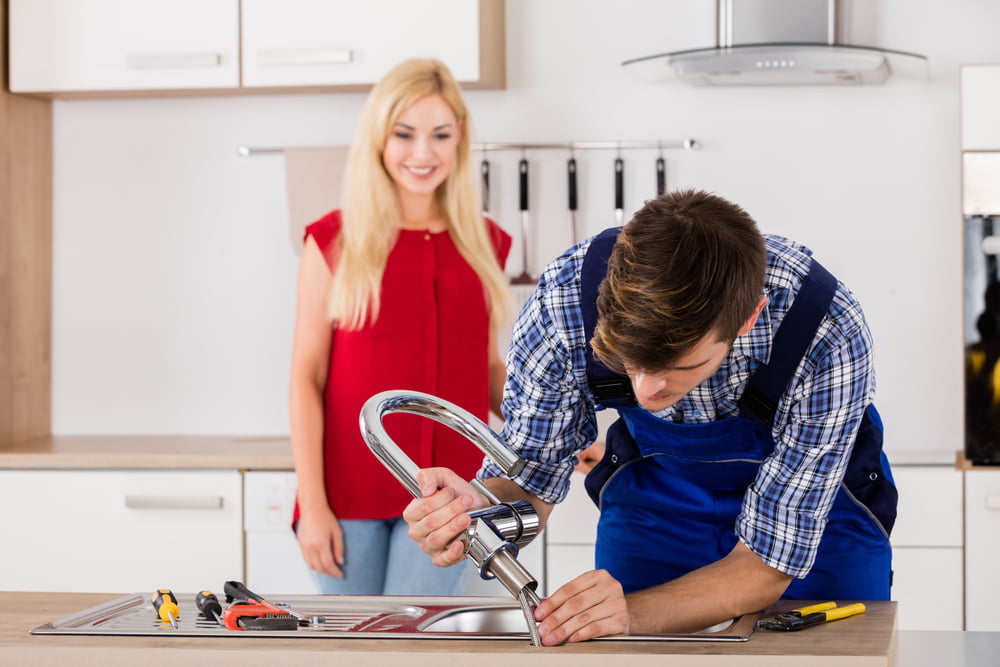
Jun 25, 2023 | Blogs, Plumbing services
A home’s plumbing system is crucial to keep a house functioning properly. However, it can be easy to overlook maintenance until there is a problem.
As a new homeowner, it is important to have some basic plumbing knowledge, so you can avoid major problems in the future. These top 8 plumbing tips will help you do just that!
1. Know Your Water Shut-Off Valve
If you have water flooding your house, knowing where the shut-off valve is located can save you money on repairs. It can also reduce the risk of injury to family members.
Look for a copper or metal pipe that extends from the ground up to your home’s foundation, and follow it to your water meter. The shut-off valve should be right before the meter. You can also find it near your exterior spigots and hose bibs. It should have a handle that turns freely.
2. Keep a Plunger and Drain Snake at Home
The plunger is an efficient and inexpensive way to handle clogs. It’s a tool every homeowner should keep handy.
For serious clogs, you can also use a drain snake, sometimes called a wire drain auger. Feed the cable into a drain until you feel resistance and the tip breaks up or catches on a clog; be sure to turn off the power while you’re working with a drain snake.
3. Protect Your Pipes from Freezing
As winter approaches, the risk of pipes freezing and bursting skyrockets. Frozen pipes are one of the most common causes of home damage and can lead to thousands of dollars in water and property damage.
Insulate exposed pipes in unheated areas: You can purchase foam insulation sleeves, available at your local hardware store, to wrap around your exposed pipes. Turn on the faucets to a slight drip during extremely cold weather, and ensure that you close any outside spigots.
4. Maintain Your Water Heater, Cistern and/or Well
Draining your water heater once a year is important to prevent sediment build-up that shortens the lifespan of the unit, while also helping to save on energy costs.
5. Know Where Your Water Supply and Drain Pipes Are Located
The water supply lines are found in many places throughout your house, delivering fresh water to shower heads, sinks, faucets and other household appliances. In some cases, these lines also lead to the water heater and outdoor hose spigots.
Your drain-waste-vent line (also called a sewer clean out) extends from your home to the municipal sewer system or septic tank. You should always know where this line is located to avoid damaging it.
6. Don’t Place Garbage Down the Drain
Food scraps, particularly greasy ones, can build up and plug drain lines. Grease from cooking oils, pan drippings and bacon should never be poured down the drain.
Place strainers over your sink and shower drains to catch hair, soap scum, and other debris before they can clog the pipes. Be sure to only flush toilet paper and human waste down the drains; anything else, including those “flushable” wipes, can cause a serious clog. Ensure that no one in the house is flushing items like paper towels, personal products, napkins, or diapers.
Foods that expand should not be put down the disposal either; this includes pasta, rice and bread. Eggshells and uncooked oats also pose a threat, since they are likely to collect other debris and form clogs.
7. Know Where Your Water Main Is Located
It’s important for homeowners to know where their water main is located and how to turn it off. This can save thousands of dollars worth of damage in the event of a major plumbing issue that requires immediate attention.
The water main shut-off valve is typically found on the home’s plumbing line as it enters from the street, usually in a basement or crawl space.
8. Turn Off the Water
The quicker you can shut off your water, or direct a plumber to the problem, the better chance you have of minimizing damage. This is especially important if you have frozen pipes.
These simple tips can help you avoid costly plumbing problems! However, in the event that you need an emergency plumber, Tap Tech is here, 24/7 with same-day service to rectify the issue.
Get in touch with Ontario’s premier emergency plumbers: call 343-305-1172 or book your visit online today!







